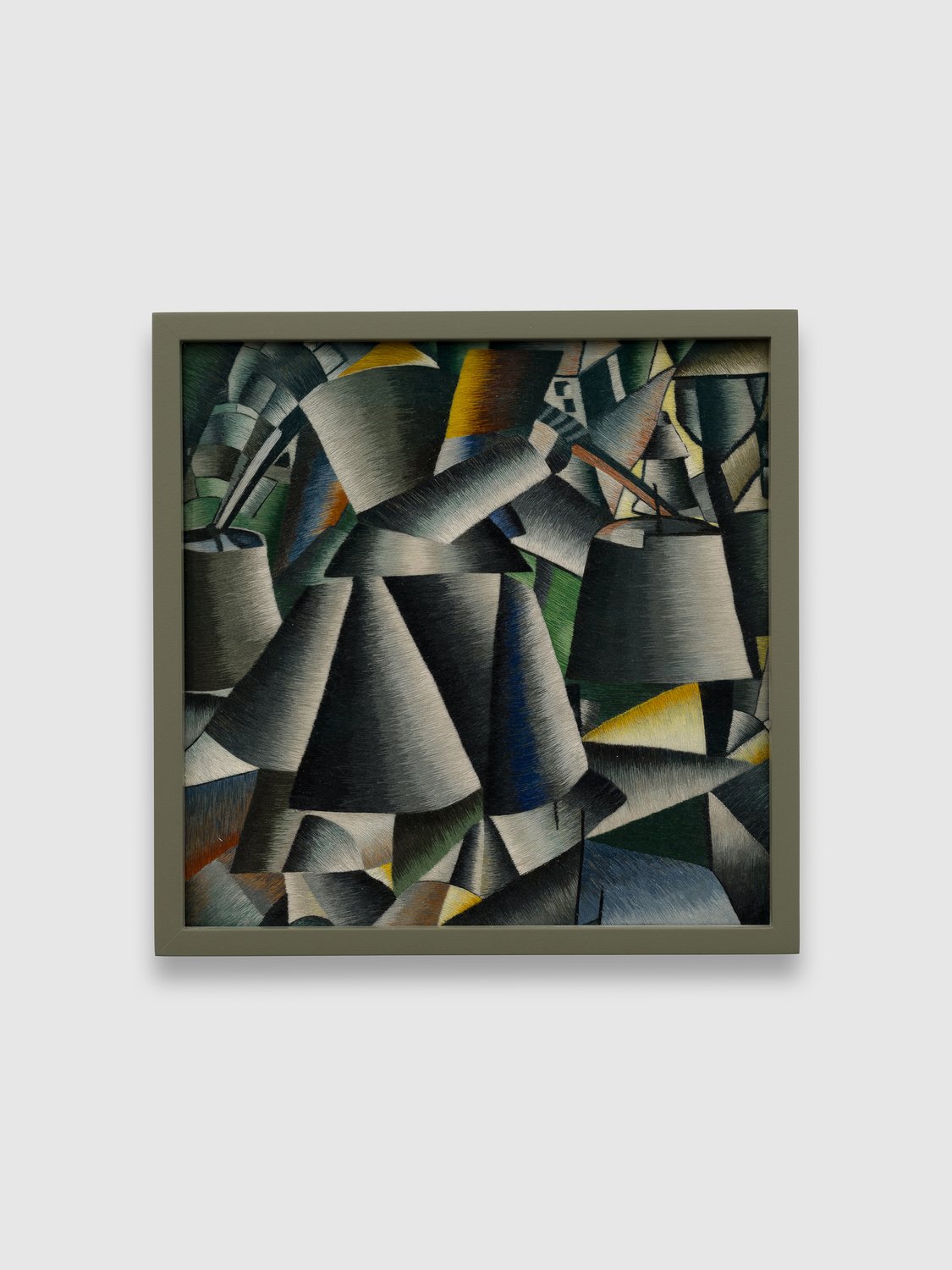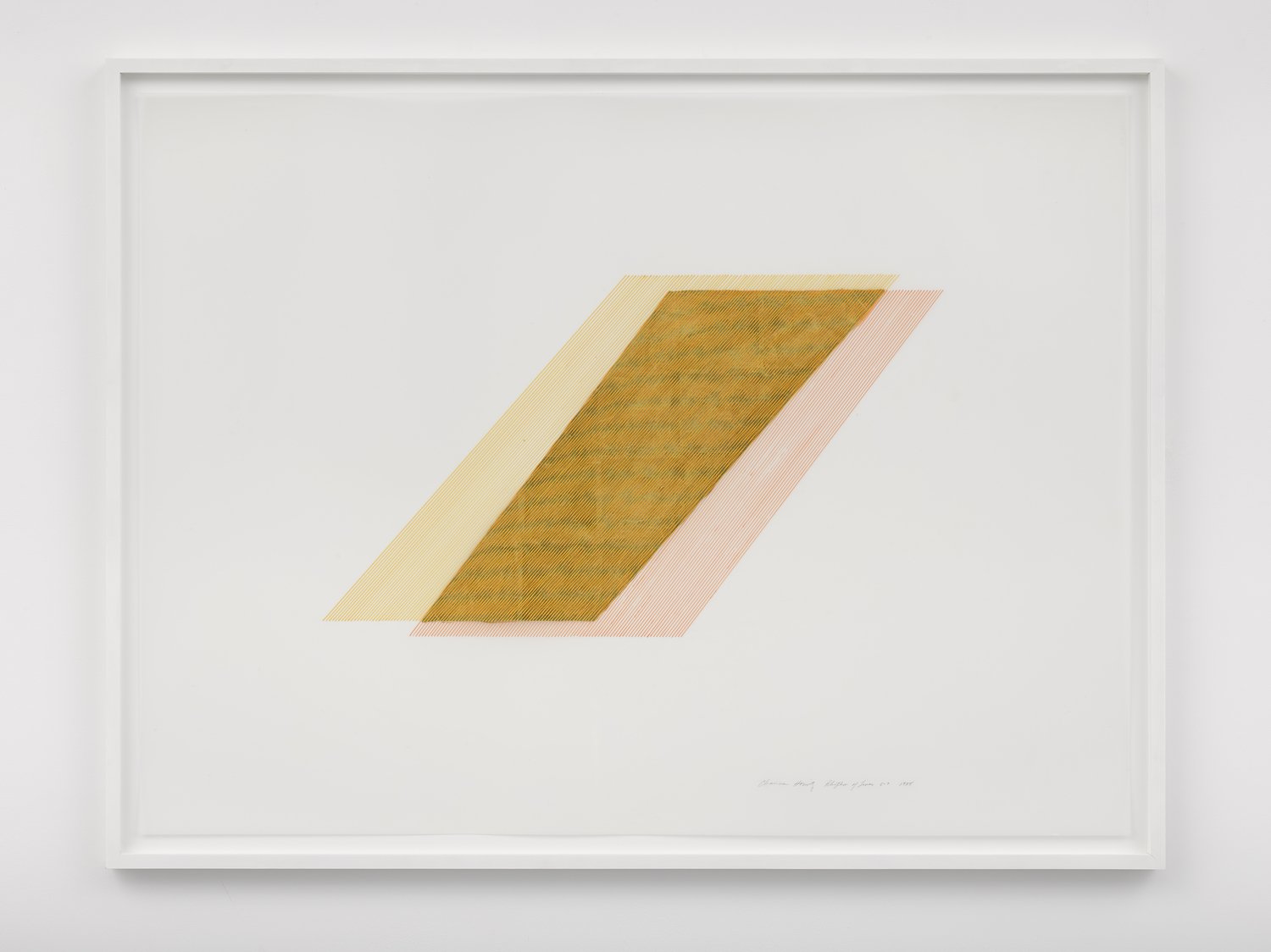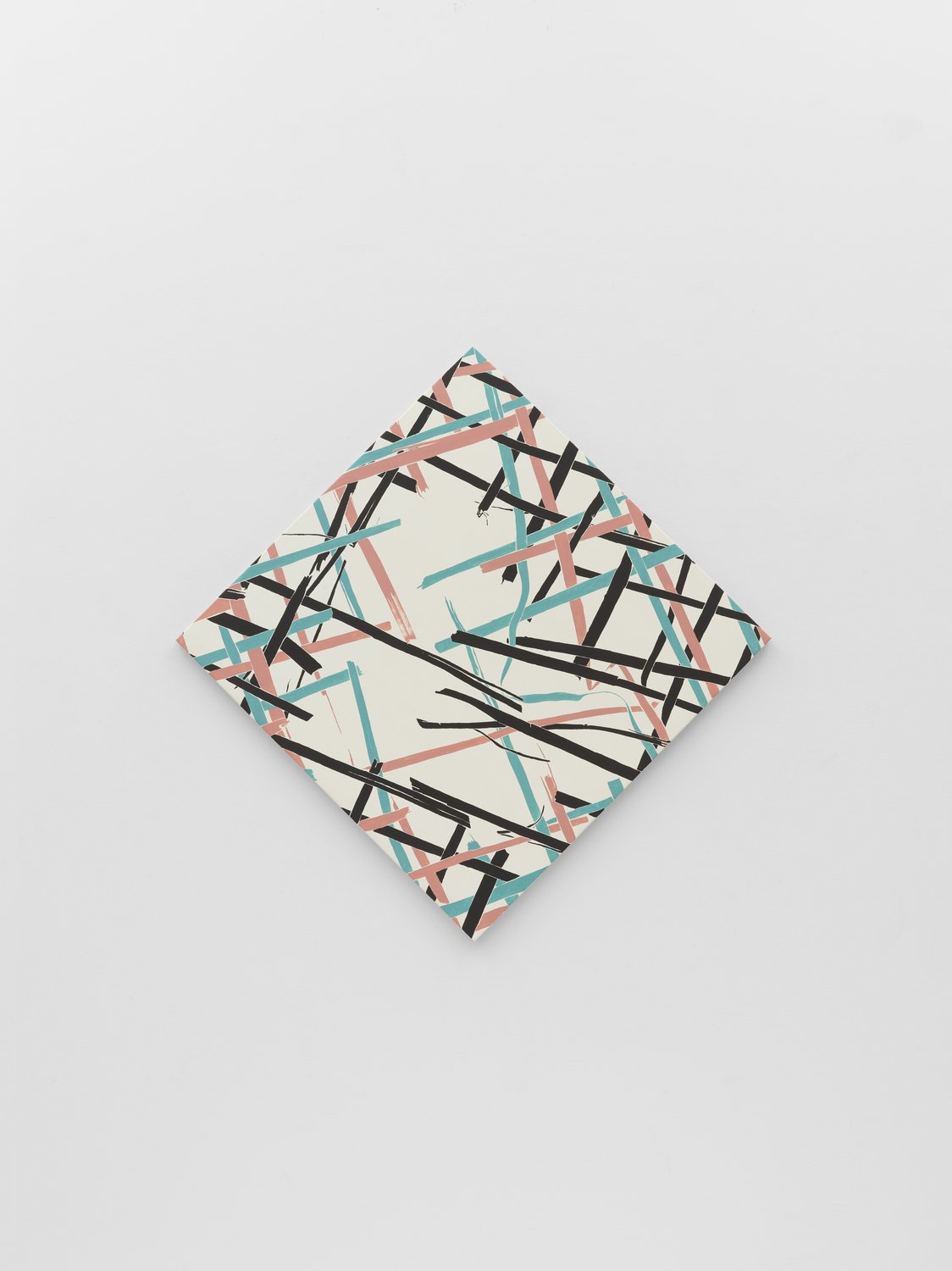Patternmaker's Maze 编织者迷宫
Wang Ye王也 Woman with Pails: Dynamic Arrangement 提桶的女人:动态组合 2021 Silk on silk handmade embroidery 手工刺绣 19.8 x 19.9 x 4.5 cm 7 3/4 x 7 7/8 x 1 3/4 in © Wang Ye. Courtesy Lisson Gallery
“Assuming that the global art industry, which revolves around everything from creation to collection, is a maze, then are the practitioners the ones setting it up or the ones finding a way out? Are we able to choose? How do we navigate through the tangled paths in this maze?”

















Installation view of Patternmaker’s Maze, Chapter I: Maze, Lisson Gallery, Shanghai, 20 July – 24 August 2024. Courtesy Lisson Gallery. Photography by Alessandro Wang
Taking its name from the labyrinth in the fantasy novel series A Song of Ice and Fire by George R. R. Martin, the group exhibition Patternmaker’s Maze attests to the complexity with which art and the artists engage in reality and the spiritual world. Extending beyond their physical existence, the artworks in this exhibition are recognized as both receivers and active contributors within a maze of socio-political, economic, and natural forces. They interact with the existing world of signs, visuality, and materiality while simultaneously questioning its structures and boundaries, breaking new grounds for interpreting the past, experiencing the present, and shaping the future.
In A Song of Ice and Fire, it is said that “only those who learn to walk [the maze] properly will find wisdom.” Presented in two chapters, ‘Maze’ and ‘Patternmakers’ , this exhibition brings together a group of artists who speak to the challenges and inspirations in the process of navigating and transforming the art world, utilising and being subject to the power dynamics within and across distinct social fields. The artworks presented in Lisson’s Shanghai gallery share a space of conversation, interweaving into a larger collective narrative while preserving their unique perspectives of being in the world. Ding Hongdan’s personal encounters in Estonia have informed the creation of the Toy Museum series, which points to the possibility of different choices made in distinct situations through figures wearing masks with multiple faces. Dressing Mirror (2024) examines human beings’ imagination for fortune and status via the stereotype perfect female image and the multi-dimensional worlds – the physical world, the world of fantasy and desire – divided by the mirror frame depicted in the composition and the frame of this painting.
Ryan Gander瑞安·甘德 Irresistible Force Paradox (LY1A) 不可抗拒的力量悖论 (LY1A) 2023 Paint on aluminium 颜料、铝材 180 x 122 x 5 cm 70 7/8 x 48 x 2 in © Ryan Gander. Courtesy the artist and Gallery Hyundai
Ryan Gander’s practice follows an associative process that bridges the mundane with the mysterious, challenging established notions of language and knowledge while reimagining the presentation and creation of artworks. In recent pieces he approaches “small things that may seem forgettable and insignificant but command our attention without requesting it, etching themselves into our memories.” In Natural Sign / Time Management (Solemn estranged moon) (2021), the artist depicts a full moon witnessed during the pandemic, a period when he experienced a drought of difference and inspiration; while the bold and colourful painting Irresistible Force Paradox (LY1A) (2023) is inspired by the cartoon Tintin – a childhood obsession and longstanding reference for Gander. Here, expressions of energy are visualised in a circle of instinctively comprehensible ‘action marks’ that signify movement, emotions and interactions between characters.
Channa Horwitz夏纳·霍维兹 Rhythm of Lines, 6-7 线条的韵律,6-7 1988 Casein and 23 karat gold leaf on Mylar 酪酸涂料、23克拉金箔、聚酯薄膜 76.2 x 101.6 cm 30 x 40 in © Channa Horwitz. Courtesy Lisson Gallery
Channa Horwitz's Rhythm of Lines, 6-7 (1988) highlights the artist’s rigorous conceptual structures and self- determined rules to capture space, movement and time with numerical sequence and lines. Each work from the Rhythm of Lines series is composed of a pairing of two sets of angled lines, creating intricate moiré patterns. The areas where the sets of lines cross are filled in with twenty-three-karat gold leaf. While the work may appear to be machine-generated, it was entirely hand-made.
Huang Tinglan黄婷岚 Behind the Reflection 镜面的背面 2024 Tapestry with cotton and wool yarn 单面织 100 x 90 cm 39 3/8 x 35 3/8 in © Huang Tinglan. Courtesy Lisson Gallery
Huang Tinglan’s practice centres around different scenes in daily life. The concept of “boxes”, to which she compares spaces, appears throughout her textile works. Characterised by two distinctive dominant colours, Place, Non-place 1 (2022) and The Exit (2022) depict her experience living in New York. The multiple textile layers resulting from the double-weave technique allude to compacted and enfolding spaces. Elsewhere, Behind the Reflection (2024) is inspired by Huang’s experiences of travel since returning to China. The boundary of “boxes” no longer exists, which is evidenced by the vibrant colour palette, the motifs of scenery and dancelike human bodies.
Christian Jankowski presents The Hunt (1992/1997), one of his earliest video works. This piece shows the artist’s one-week supermarket shopping experience during which, with an intention to rebel against modern society and to return to nature, he 'hunts down' groceries, shooting each item with a bow and arrow. Through comic incongruities, Jankowski humorously suggests that 'natural ways’, such as the act of hunting, and capitalist circulation, are not necessarily mutually exclusive.
Richard Long理查德·朗 Untitled 无题 2010 White china clay on black card 高岭土、黑色卡纸 101 x 143 cm 39 3/4 x 56 1/4 in © Richard Long. Courtesy Lisson Gallery
Richard Long makes a striking image in Untitled (2010) using white China Clay and the most elemental of means, his own hands, demonstrating his primeval fascination with mark-making. “All my work is simple. I like the primal energy of just handprints or fingerprints. It’s like cave painting.” Known for creating works that trace his physical movement through space, Untitled (2010) emphasises Long’s preoccupation with the physical engagement of the body in his work.
Otobong Nkanga奥托邦戈·恩坎加 Silent Anchor I 沉默的锚I 2023 Hand-blown glass and hand woven rope 手工吹制玻璃、手工编织绳索 Installed/装置后尺寸: 16 x 73 x 86 cm, 6 1/4 x 28 3/4 x 33 7/8 in © Otobong Nkanga. Courtesy Lisson Gallery
Otobong Nkanga’s Silent Anchor I (2023) presents a circuitry of hand-dyed rope and biomorphic glass forms, conceived as a spatial cleanser or talisman. A shallow well on the surface of the glass holds an offering of lavender oil, a substance believed to have healing, soothing and anti-inflammatory properties. The sculpture amplifies and extends the concept of energetic intervention beyond the body and into the spatial realm, suggesting a permeable boundary between the two domains.
Ren Jie任倢 Night Watch: The Origin of the World 3 夜巡:世界的起源3 2023 Wood frame with hand-woven reflexive textile and felt 木框、手工编织反光织物和毛毡 30.5 x 30.5 x 2 cm 12 x 12 x 0 3/4 in ed. 1 of 3 + 1 AP © Ren Jie. Courtesy Lisson Gallery
Ren Jie’s Night Watch series coalesces materials, everyday images as well as visual and physical experiences of contemporary life through the lens of the entanglement between textile techniques and modern computer technology. This series invites viewers to engage with the dialogue between space and materiality in a world dominated by fleeting digital viewing experiences, generating new interpretations on the subjects of labour and gender and unleashing the imagination around these topics from a literature perspective.
Shen Ruijun沈瑞筠 Swan Lake 天鹅湖 2016 Mixed-media with plinth综合材料、底座 45 x 120 x 45 cm 17 3/4 x 47 1/4 x 17 3/4 in © Shen Ruijun. Courtesy Lisson Gallery
Shen Ruijun’s mixed media installation Swan Lake (2016) depicts a state of multi-dimensionality, change, and unity of opposites. The piece’s utilisation of one-way mirror glass leads to different images appearing from different viewing angles. Referencing the duality and underlying, multi-faceted nature of the female characters in its namesake ballet masterpiece, the work highlights the perpetual change and repetition in time, places and contexts.
Shi Zheng 施政 BINE 蔓 2019 Single channel video installation, LED screen 单频影像装置、LED屏幕 © Shi Zheng Courtesy Lisson Gallery
Shi Zheng removes the images and texts from the front page of The New York Times, then trains an Artificial Neural Network to learn the data set consisting of lines between the columns. In the resulting single-channel video BINE (2019), the shifting and orderly lines appear and diminish to compose a body that continuously grows. Once acting as "the silhouette" that divided information, event, and time, the work explores “latent space” and delineates time by tracing its varying boundaries and framework.
Cheyney Thompson切尼·汤普森 Caning [4, interval] 藤茎 [4, 子域] 2023 Acrylic on canvas 布面丙烯 Installed/装置后尺寸: 118.1 x 118.1 x 2.2 cm, 46 1/2 x 46 1/2 x 7/8 in Square/画布大小: 83.5 x 2.2 cm, 32 7/7 x 32 7/8 x 7/8 in ©Cheyney Thompson. Courtesy Lisson Gallery
Cheyney Thompson started creating his Caning paintings series in 2004. In Caning [4, interval] made in 2023, the artist continues his exploration of structure through a weaving motif. Living in a highly structured world, Thompson considers the notion that structures are themselves built on contradictions. If a motif carries with it a trace of motivation, then these paintings are concerned with what can happen when structures are strained to a point of failure.
Wang Ye王也 Seated Bather 女坐浴者 2020 Silk on silk handmade embroidery 手工刺绣 19.9 x 15.7 x 4.5 cm 7 7/8 x 6 1/8 x 1 3/4 in © Wang Ye. Courtesy Lisson Gallery
Wang Ye develops his narratives by using traditional, hand-made embroidery techniques, originated in Hunan in the artist’s Embroidernity series. Moth (2022) was inspired by a giant moth he saw on a rusty window in his childhood. Having never seen the same type of moth again, he questioned whether such an experience was a dream or a missing memory. Subsequently, Wang identified the potential species by remembrance. Through this representation, the artist furthers his explorations of Chinese folk art technique and aesthetics.
About Lisson Gallery
Lisson Gallery is one of the most influential and longest-running international contemporary art galleries in the world. Today, the gallery supports and promotes the work of more than 70 international artists across spaces in London, New York, Los Angeles, Shanghai, and Beijing. Established in 1967 by Nicholas Logsdail, Lisson Gallery pioneered the early careers of important Minimal and Conceptual artists, such as Art & Language, Carl
Andre, Daniel Buren, Donald Judd, John Latham, Sol LeWitt, Richard Long and Robert Ryman among many others. It still works with many of these artists and others of that generation, from Carmen Herrera and Olga de Amaral to Hélio Oiticica and Lee Ufan. In its second decade the gallery introduced significant British sculptors to the public for the first time, including Tony Cragg, Richard Deacon, Anish Kapoor, Shirazeh Houshiary and Julian Opie. Since 2000, the gallery has gone on to represent many more leading international artists such as
Marina Abramović, Ai Weiwei, John Akomfrah, Liu Xiaodong, Otobong Nkanga, Pedro Reyes, Sean Scully, Hiroshi Sugimoto and Wael Shawky. It is also responsible for raising the international profile of a younger generation of artists including Dana Awartani, Cory Arcangel, Garrett Bradley, Ryan Gander, Josh Kline, Hugh Hayden, Haroon Mirza, Laure Prouvost and Cheyney Thompson.
Artists:
Ding Hongdan | Ryan Gander | Channa Horwitz | Huang Tinglan | Christian Jankowski | Richard Long | Otobong Nkanga | Ren Jie | Shen Ruijun | Shi Zheng | Cheyney Thompson | Wang Ye
Chapter I: Maze | 20 July – 24 August 2024
Chapter II: Pattern Makers | 31 August – 12 October 2024
There was an opening on July 20th of this year
For more information about this exhibition and others, please visit the Lisson Gallery here. The gallery can also be found on Facebook, YouTube, and Instagram.










